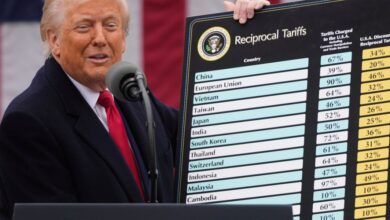

Weight loss drugs like Wegovy and others have some retailers scrambling to meet the demand for smaller sizes.
Rent the Runway, a clothing rental subscription service, has seen the trend toward smaller sizes firsthand. CEO and cofounder Jennifer Hyman told the Wall Street Journal that more customers are switching to smaller sizes than at any time in the past 15 years. The company is especially catering to women that may be changing up their clothing size, Hyman said.
“As a company we have spent years perfecting our fit algorithms to ensure that women who are either gaining weight or losing weight can find the perfect size,” Hyman told Fortune in an email.
A Monday study by Impact Analytics, which uses AI tools to help retailers with inventory decisions, found that demand for smaller sizes is skyrocketing in some areas. Sales of women’s button-down shirts in small sizes (XXS, XS, and S) have increased 12% this year compared to 2022. Meanwhile, sales of larger sizes including XXL, XL, and L, have decreased about 11% compared to 2022, Impact Analytics found through a study of retailers located in Manhattan’s Upper East Side neighborhood.
“The slimming down of America will have an enormous impact on retailers and could cost them approximately $20 million each year due to incorrect size curves,” said Impact Analytics CEO Prashant Agrawal in a statement.
The shift to smaller clothing sizes has also started to affect how retailers are looking at their inventory, according to a report by Impact Analytics. Retailers have for years clung to a rigid set of sizes, which aren’t necessarily meeting consumers’ preferences and can lead to missed sales and losses, Impact Analytics wrote. The proliferation of GLP-1s, which are used to treat diabetes but can also trigger weight loss, is making this problem worse and could see retailers left with 10% of their inventory unsold at the end of the year if they don’t adapt to changing preferences.
Inaccurate sizing is a headache for retailers with already tight margins, and can lead to missed sales when customers can’t find the size they need. Forecasting and making the right purchasing decisions is crucial because retailers start planning and can purchase inventory about a year ahead of time, according to Impact Analytics. Retailers lose $1 trillion a year just by not having the sizes customers want, according to retail analyst IHL Group.
“To put it bluntly: In a market where precision and adaptability are paramount, failing to adjust to this dramatic shift in body sizes could spell financial catastrophe for fashion retailers,” Impact Analytics wrote.
Listening to consumer preferences is especially important for an industry that has seen stagnant sales numbers in recent months. Sales at clothing and clothing accessory stores have remained flat at just under $26 billion per month in the U.S. since January, according to data from the Census Bureau.
Skyrocketing demand for Wegovy and other weight loss drugs
The Food and Drug Administration approved Novo Nordisk’s Wegovy for use as a weight loss drug in 2021; since then demand for it and similar drugs has exploded. An estimated 15.5 million people in the U.S., or about 6% of adults, have used injectable GLP-1s, according to a May survey by Gallup. The groups most likely to use the drugs are women, people with insurance, and older adults between the ages of 40 to 64, according to Gallup.
Retailers that target people in the groups more likely to use GLP-1s, such as women or people with higher incomes, will be more affected by changing size preferences, Impact Analytics said. However, these types of consumers are also more likely to splurge on “revenge shopping” after losing weight—and that could present an opportunity for retailers as well.
The impacts of Wegovy on clothing size preferences may still increase in the future because outsized demand has led to shortages of the drug and others like it. Last month, telehealth company Ro launched a free tool to help track down GLP-1 doses from pharmacies through user input. In three weeks, users have sent in 35,000 submissions to notify the tracker that a pharmacy did not have the GLP-1 drug the user was looking for. Those submissions vastly outnumber the 1,500 submissions users sent over the same period to notify the tracker that a GLP-1 was in stock. The company said it continues to receive hundreds of shortage submissions daily.
Source link




